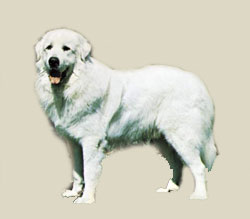
Country of Origin: Central Asia
Group: Pinscher and Schnauzer - Molossoid Breeds - Swiss Mountain and Cattle Dogs
Section: Molossoid breeds
Original Function: draft, search and rescue
Todays Function: companion
Dimension Male: 69-81 cm
Dimension Female: 63-74 cm
Weight Male: 45-50 kg
Weight Female: 36-40 kg
Litter Size: 2-12 puppies
Life span: 8-10 years
Other Names: Pyrenean Mountain Dog, Chien de Montagne des Pyren
Colors: Coat is either solid white or white with patches of tan, wolf-gray, reddish-brown or pale yellow.
Living: These dogs are not recommended for apartment life. They need space, but adapt well to family life. T
Recognized: CKC, FCI, AKC, UKC, KCGB, CKC, ANKC, NKC, NZKC, APRI, ACR, DRA
Description
The Great Pyrenees is also known as the Pyrenean Mountain Dog. The length of the dog is slightly longer than it is tall. The head is wedge-shaped with a slightly rounded crown and is in proportion to the rest of the body. The backline is level. The muzzle is about the same length as the back skull. The skull is as wide as it is tall with flat cheeks. There is no apparent stop. The nose and lips are black. The teeth meet in a scissors or level bite. The dark brown, medium sized eyes are almond shaped and slanted. The dark brown, V-shaped ears are carried low, flat and close to the head, rounded at the tips, set about eye level. The chest is fairly broad. The well feathered tail reaches the hocks and can be carried low, or up over the back in a wheel when the dog is excited. There is sometimes a crook at the end of the tail. The Great Pyrenees has single dewclaws on the front legs and double dewclaws on the hind legs. The dog has a weather-resistant double coat. The undercoat is dense, fine and wooly, and the outer coat is long, thick, coarse and flat. There is a mane around the shoulders and neck which is more apparent in male dogs. There is feathering on the tail and along the back of the legs. Coat is either solid white or white with patches of tan, wolf-gray, reddish-brown or pale yellow.
Temperament
The Great Pyrenees is a capable and imposing guardian, devoted to its family, and somewhat wary of strangers - human or canine. They are often used to guard livestock. When not provoked, it is calm, well- mannered, and somewhat serious. Courageous, very loyal and obedient. Gentle and affectionate with those he loves. Devoted to family even if self-sacrifice is required. It is very gentle with its family and children. It does best with children when it is raised with them from puppyhood, and if they are not being used as working flock guards be sure to socialize them well with people, place and noises. It has an independent nature, and may try to dominate a less secure or meek owner, and/or an owner who treats the dog as if he is human, becoming stubborn or territorial. Owners need to be firm, but calm, confident and consistent with the dog. Setting rules the dog must follow and sticking to them. A serious worker, but very independent. Be patient when training the Great Pyrenees, as it may be slightly difficult. If left alone inside the home without the proper amount of exercise and or leadership they can become destructive. The Great Pyrenees is good with non-canine animals, and usually loves cats. These dogs do not reach maturity until they are about 2 years old. Some are not good off the leash and may wander away. The Great Pyrenees tend to bark a lot and some tend to drool and slobber.
Excercise
Pyrenees need plenty of exercise to stay in shape. If they are not actively working as a flock guardian, they need to be taken on a daily, long brisk walk.
Grooming
Regular brushing of the long double coat will keep it in good condition, but extra care is needed when the dog is shedding its dense undercoat. The outer coat does not mat unless there is a burr, foxtail or some other outside object that gets stuck to the
Health
Major concerns: CHD, gastric torsion, entropion, ectropion, distichiasis, elbow dysplasia, osteosarcoma
Minor concerns: OCD, diabetes, heart conditions, cardiomyopathy, pyotraumatic dermatitis
Occasionally seen: epilepsy
Suggested tests: hip, elbow, cardiac, eye

